Of course, Würzburg couldn’t be missed on our extensive Franconia tour. After traveling primarily in smaller cities like Eichstätt, Ansbach, Fürth, Kulmbach, Forchheim, and Dinkelsbühl, we were now looking forward to the small “metropolis” in Lower Franconia. Würzburg has around 128,000 inhabitants, making it the second-largest city in Franconia after Nuremberg, closely followed by Fürth and Erlangen. What immediately struck us when we arrived: Würzburg is not a typical half-timbered town, as we were used to from other places.
In this charming city on the Main River, centuries-old traditions blend harmoniously with the pulse of modern life. Not to mention the idyllic landscape, characterized by rolling vineyards and historic buildings. In the following article, we introduce you to some of Würzburg’s attractions and reveal what you absolutely shouldn’t miss in the city. Enjoy browsing!
- Interesting facts about the city of Würzburg
- The most beautiful sights in Würzburg
- Restaurants & Cafés
- Events in Würzburg
- Our hotel in Würzburg
- Travel tips for Würzburg
Interesting facts about the city of Würzburg
Würzburg is the seventh largest city in Bavaria and the capital of Lower Franconia. Of the approximately 128,000 inhabitants, over 26,000 are students, who ensure a lively and dynamic life in the city. Did you know that Dirk Nowitzki was born in Würzburg on June 19, 1978? Or that the city with over 60 churches is the city with the most places of worship in Germany? Würzburg even has its own Wikipedia. The Würzburg Wiki website offers an incredible amount of information about the city on the Main River.
The city is home to the Julius Maximilian University, one of the oldest universities in Germany. Founded in 1402, the university has a rich academic tradition and has produced several famous personalities, including Wilhelm Conrad Röntgen, who received the Nobel Prize in Physics in 1901. The university’s disciplines of psychology, biology, chemistry, computer science, medicine, and physics enjoy an excellent reputation.
The region around Würzburg is also famous for its wine production, particularly Franconian wine. The city lies on the Main River and offers ideal conditions for growing grapes. In the Würzburg area, you’ll find numerous wineries and vineyards that can be visited. For example, there is the Staatlicher Hofkeller Würzburg, which, with over 800 years of history, is one of the oldest wineries in Germany.
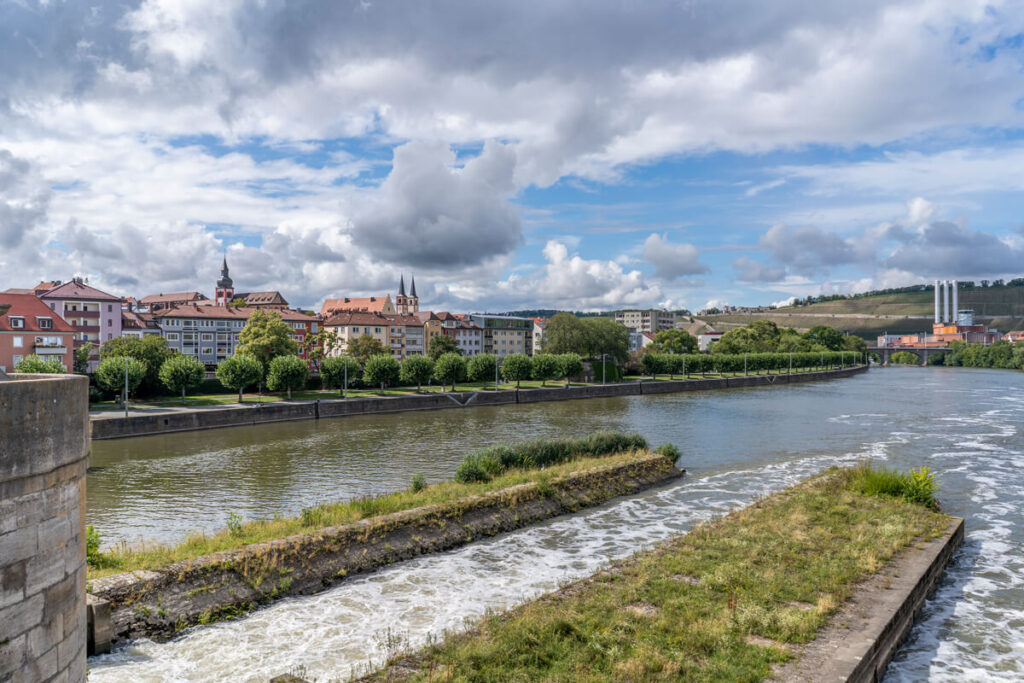
The most beautiful sights in Würzburg
Numerous beautiful sights and highlights await you in Würzburg. We recommend at least two full days to explore the city. You can easily explore the sights on foot and combine them with a long walk.
1. Würzburg Residence with Court Garden
The Würzburg Residence is definitely one of the top sights in Würzburg. Designed by Balthasar Neumann in the 18th century, it is a stunning example of the Baroque style. Since 1981, the residence has even been a UNESCO World Heritage Site. Described as a masterpiece of the Baroque period, the residence features a magnificent façade, opulent interiors, and elaborate stucco work. Particularly impressive is the staircase, considered one of the most beautiful in Europe. Unfortunately, we did not have time to explore the residence from the inside, which we will do on our next visit.
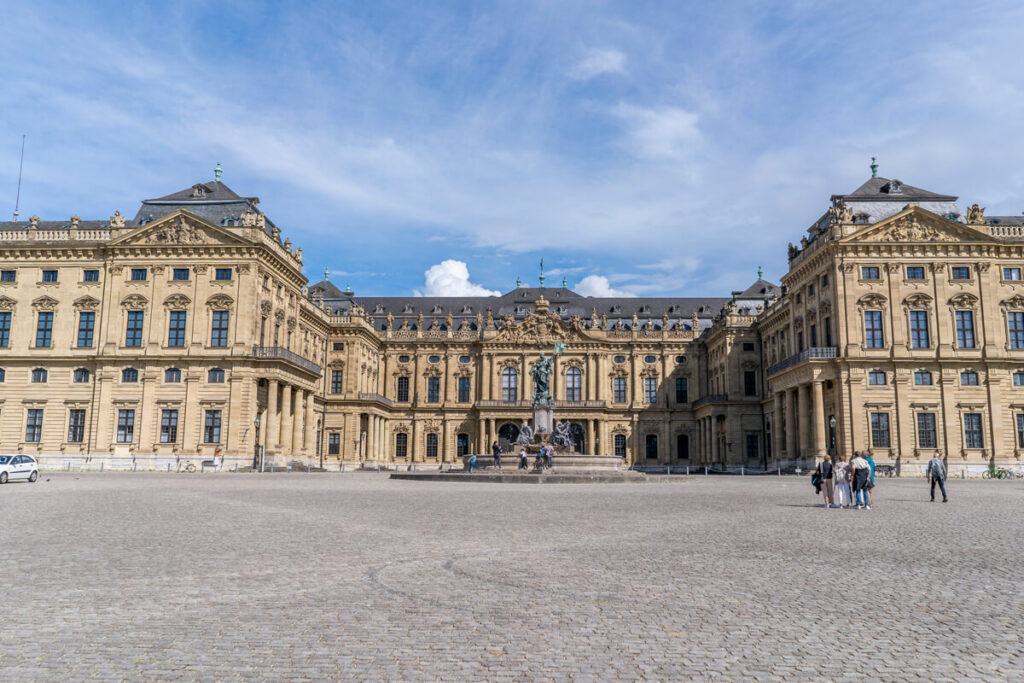
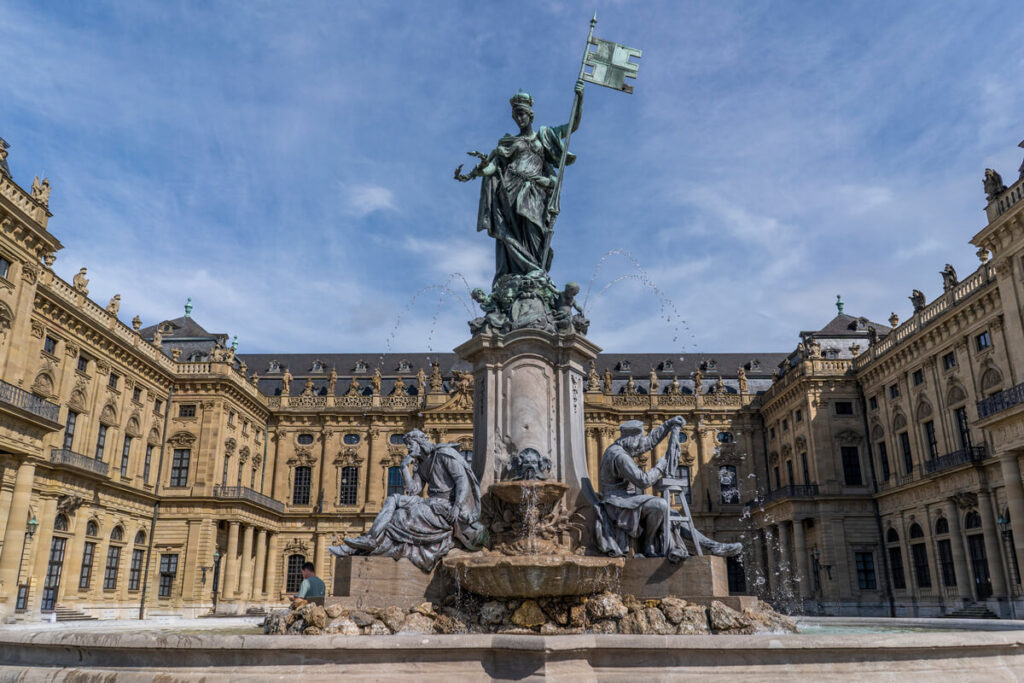

The Court Garden of the Residence is a beautiful Baroque garden that extends behind the main building. It is symmetrically laid out and features elaborate hedges, sculptures, and a central water feature. The Residence and the Court Garden are open to visitors. You can explore the 40 magnificent rooms, the staircase, the idyllic Court Garden, and the surrounding buildings. The Würzburg Residence is also the venue for various cultural events, including concerts, exhibitions, and theater performances.
Information about the Würzburg Residence:
- Address: Residenzplatz 2, 97070 Würzburg
- Opening hours: April-October: daily 9 a.m.-6 p.m. | November-March: daily 10 a.m.-4:30 p.m.
- Admission prices: €9 regular | €8 reduced (free admission for children under 18)
- Court Garden: free admission to the Court Church and the Court Garden
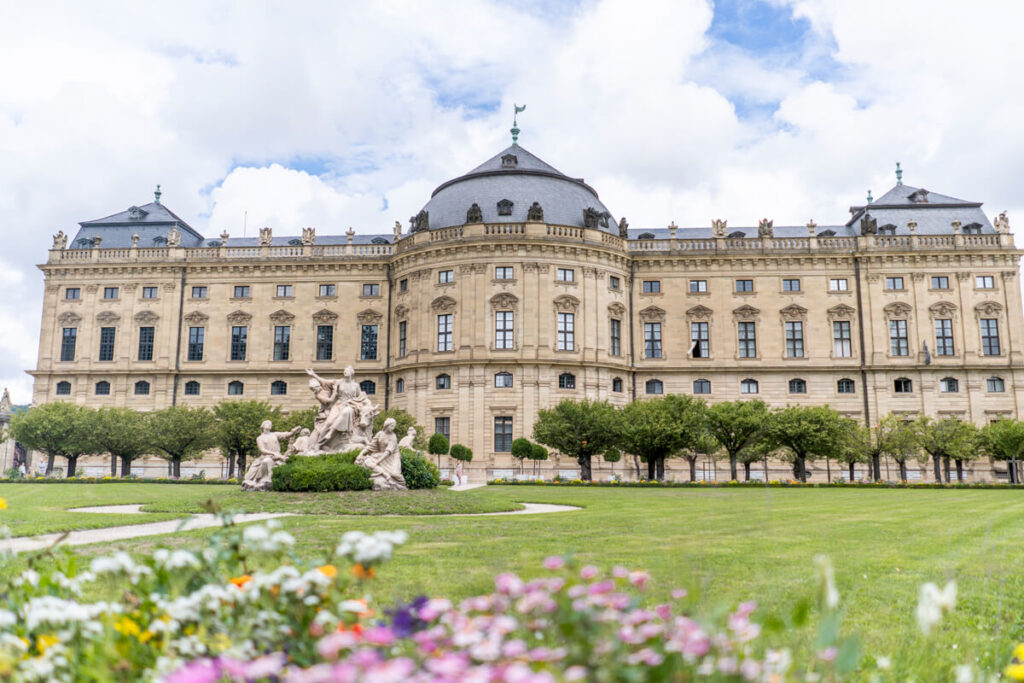
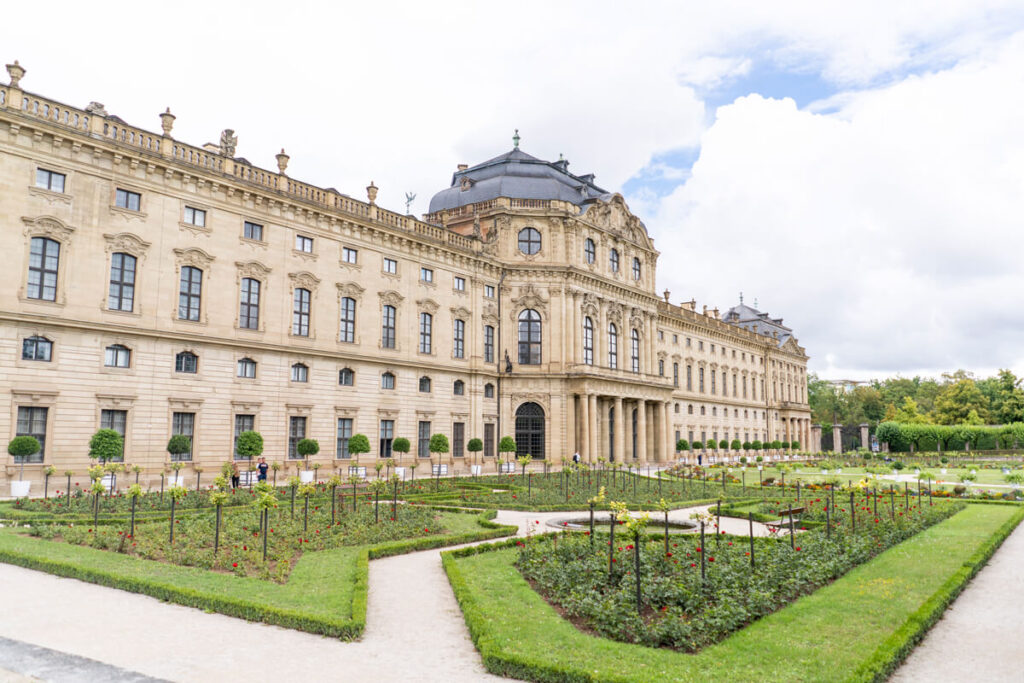
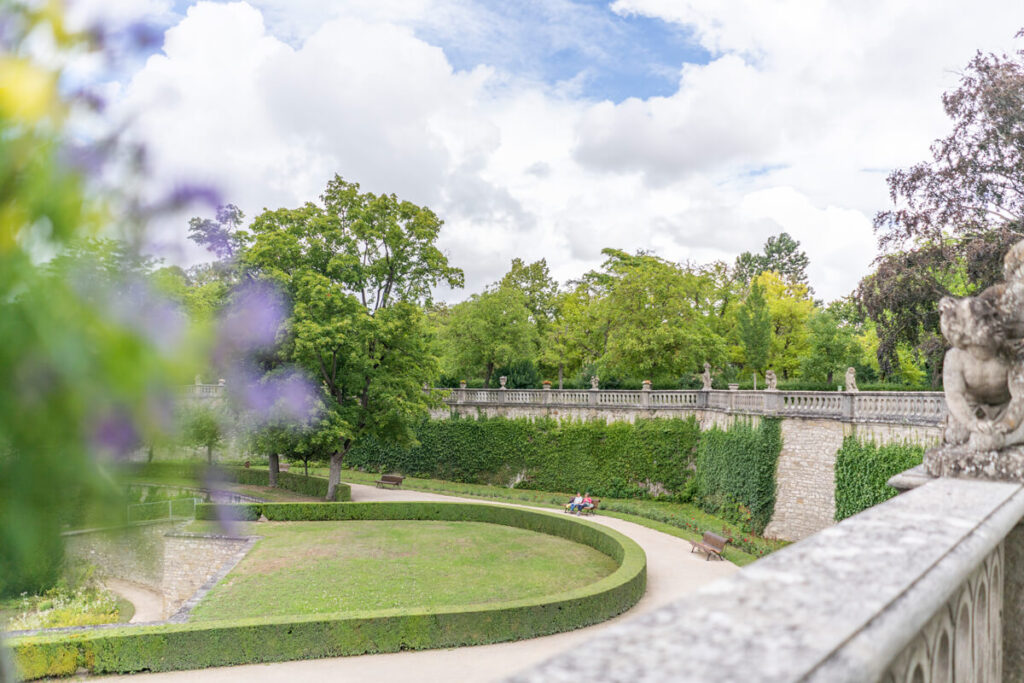
2. St. Kilian’s Cathedral
Another highlight in Würzburg’s city center is St. Kilian’s Cathedral (also called Kiliansdom) with its twin-towered façade. It is the fourth largest Romanesque church building in Germany and an outstanding example of German architecture from the time of the Salian emperors. The interior of the Würzburg cathedral contains several remarkable works of art. These include the impressive baptismal font from 1279 and an impressive collection of bishops’ epitaphs. Also worthy of special mention are the tombs of the Prince-Bishops Rudolph von Scherenberg (1495) and Lorenz von Bibra.
The Schönborn Chapel, a work by Balthasar Neumann, is another special work of art inside the cathedral. Equally impressive is the Klais organ from 1968, which represents the largest trumpet symphony in Germany and fills the cathedral’s acoustics with its sounds. Würzburg Cathedral plays an important role as a place of pilgrimage in the diocese. Every year, thousands of believers flock to Würzburg to commemorate the three Franconian apostles Kilian, Kolonat, and Totnan during the Kiliani Pilgrimage Week.
- Address: Domstraße 40, 97070 Würzburg
- Visit times: Mon-Sat: 10:00 a.m. – 6:00 p.m. | Sun: 1:30 p.m. to 5:00 p.m. (outside of church services)
- Special features: From the Tuesday after Easter until the end of October, the large cathedral organ will be heard during the “Organ Impulse” every Monday to Saturday at 12:05 p.m.
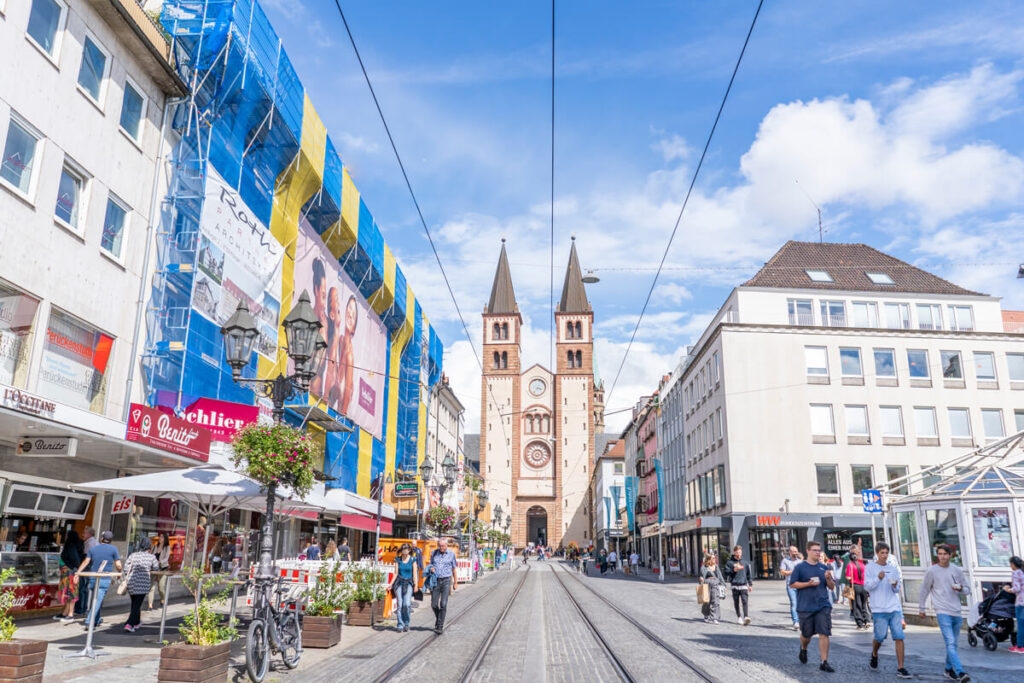
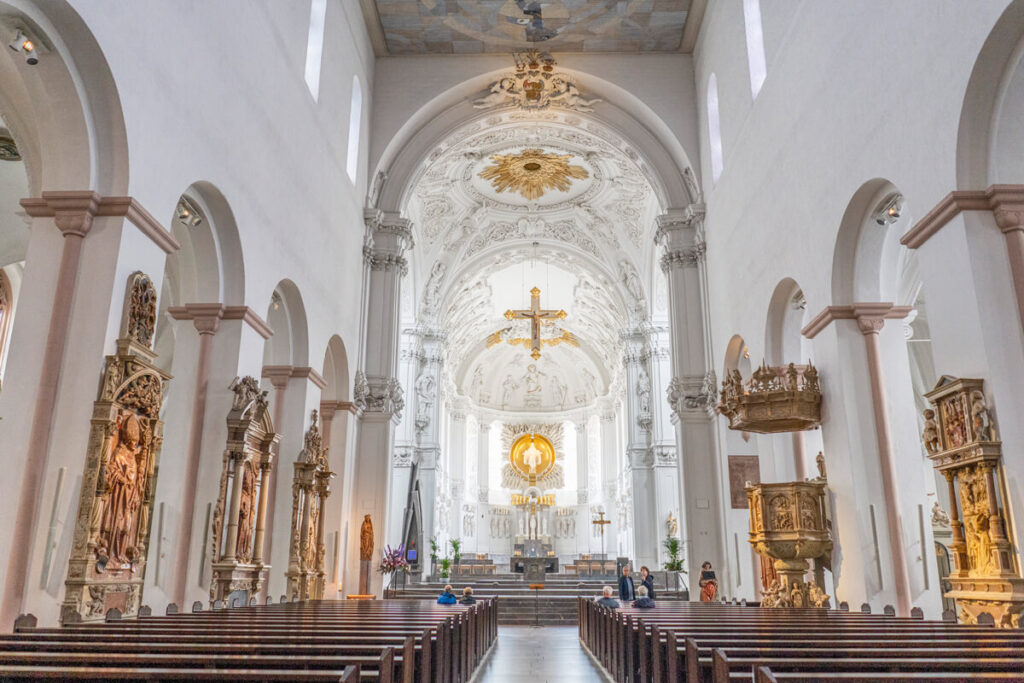
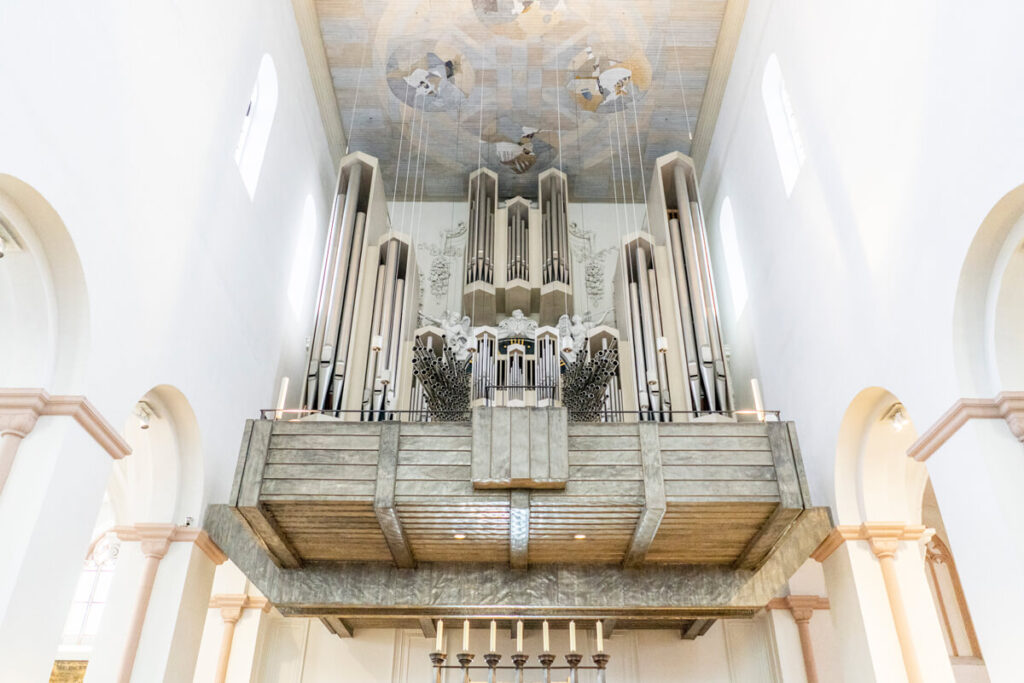
3. St. Mary’s Chapel
During our exploration, we naturally also noticed the striking St. Mary’s Chapel, located directly on the market square. Construction of the chapel began in 1377 and was finally completed around 1480 with the construction of the tower. However, the chapel was built against the wishes of the Prince-Bishop and subsequently never received parish rights. Therefore, it is “only” a chapel and not a church.
The St. Mary’s Chapel is characterized by its impressive architecture, including high Gothic vaults, ornate windows, finely crafted sculptures, and portals by the renowned sculptor Tilman Riemenschneider. The chapel is crowned by a majestic spire (70 meters high), on which a five-meter-high statue of the Virgin Mary sits enthroned in gilded splendor.
- Address: Marktplatz 7, 97070 Würzburg
- Visit times: Mon-Sat: 8:30 a.m. – 6:00 p.m. | Sun: 1:00 PM – 6:00 PM (outside of church services)
- Special features: The carillon rings daily at 12:05 PM and 6:05 PM
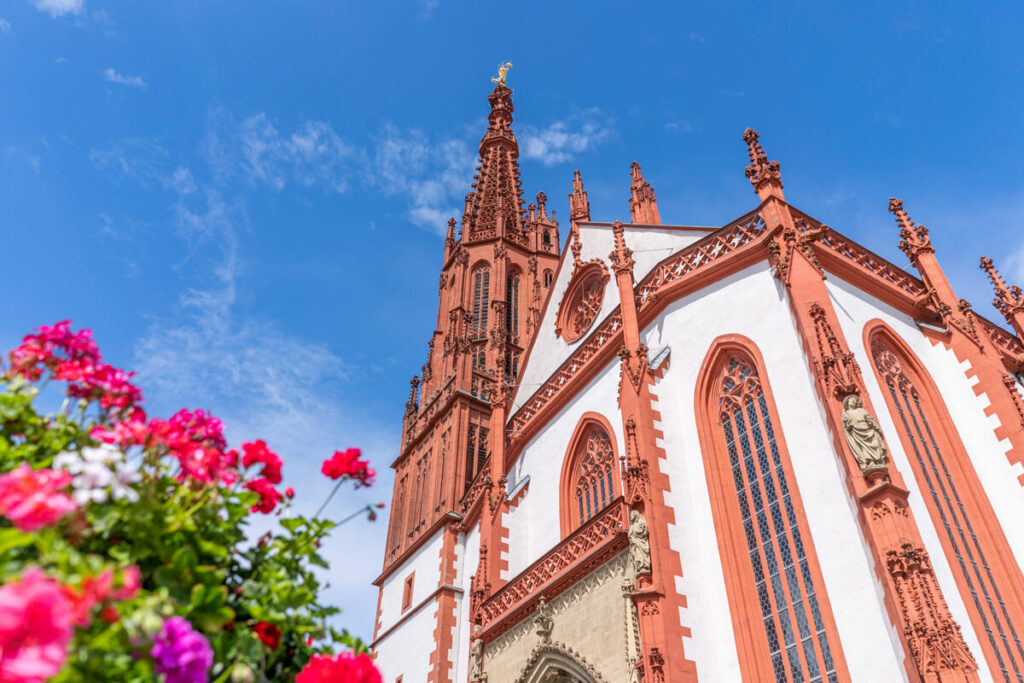
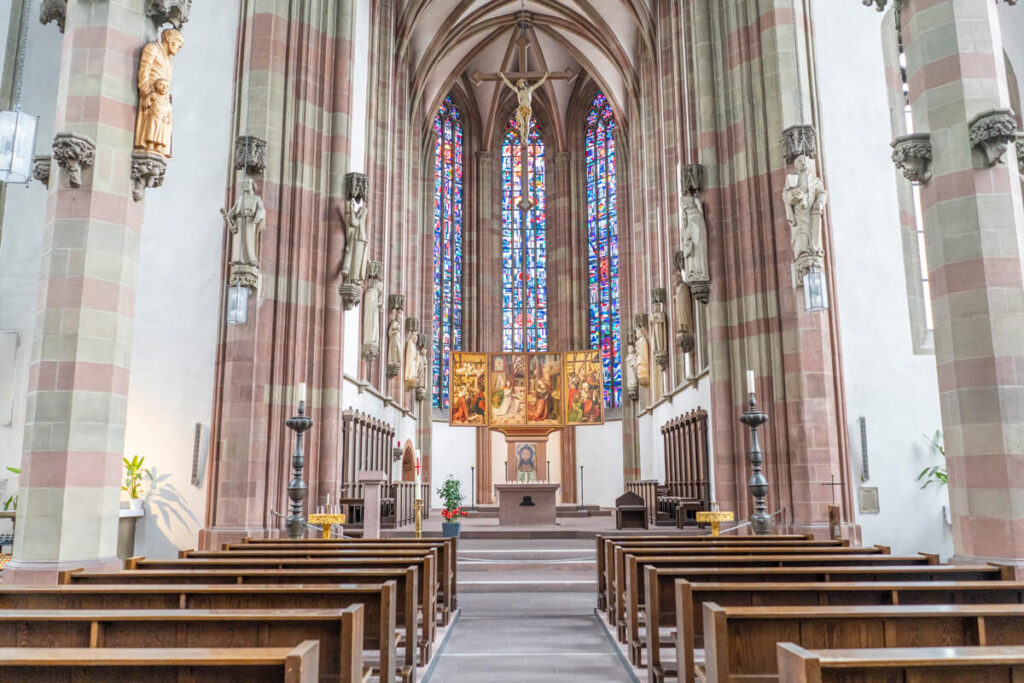
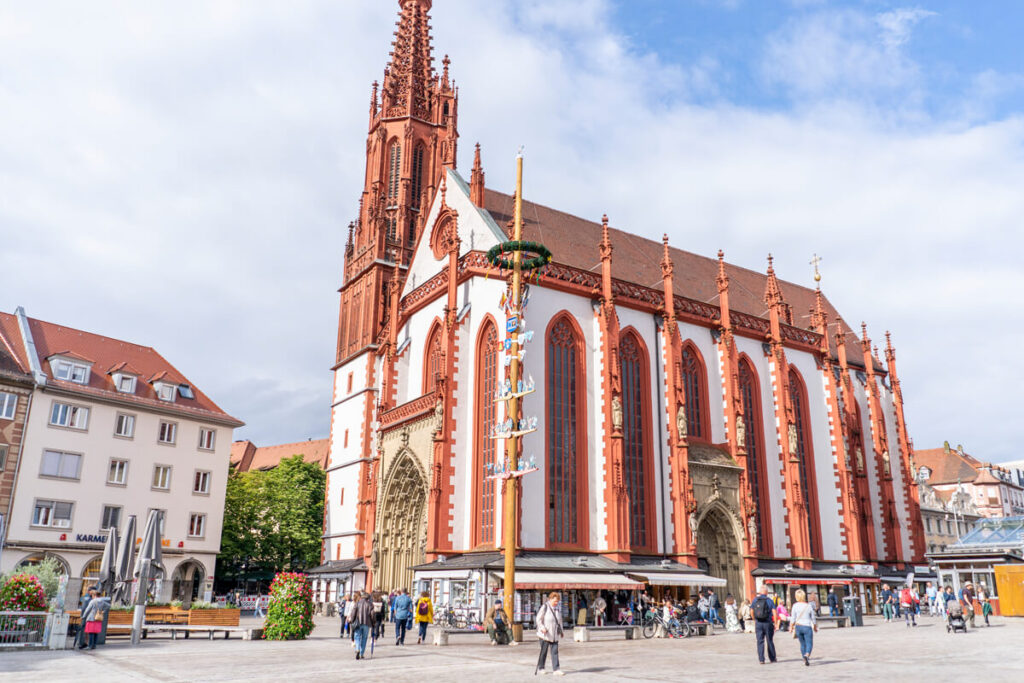
4. Falcon House
Right next to the Marienkapelle, another building catches the eye: the so-called Falcon House. This was the residence of the cathedral priest in the Middle Ages, which passed into the possession of Franz Thomas Meißner in 1735. In 1751, Barbara Meißner, the widow of Franz Thomas Meißner, decided to have the facade of the house lavishly decorated.
For this purpose, she commissioned traveling stucco artists from Upper Bavaria, who adorned the building with splendid Rococo stucco decoration. Today, the Falkenhaus, with its unique curved gables, is considered one of the most beautiful Rococo facades in all of southern Germany. The city library and tourist information office are also located on site.
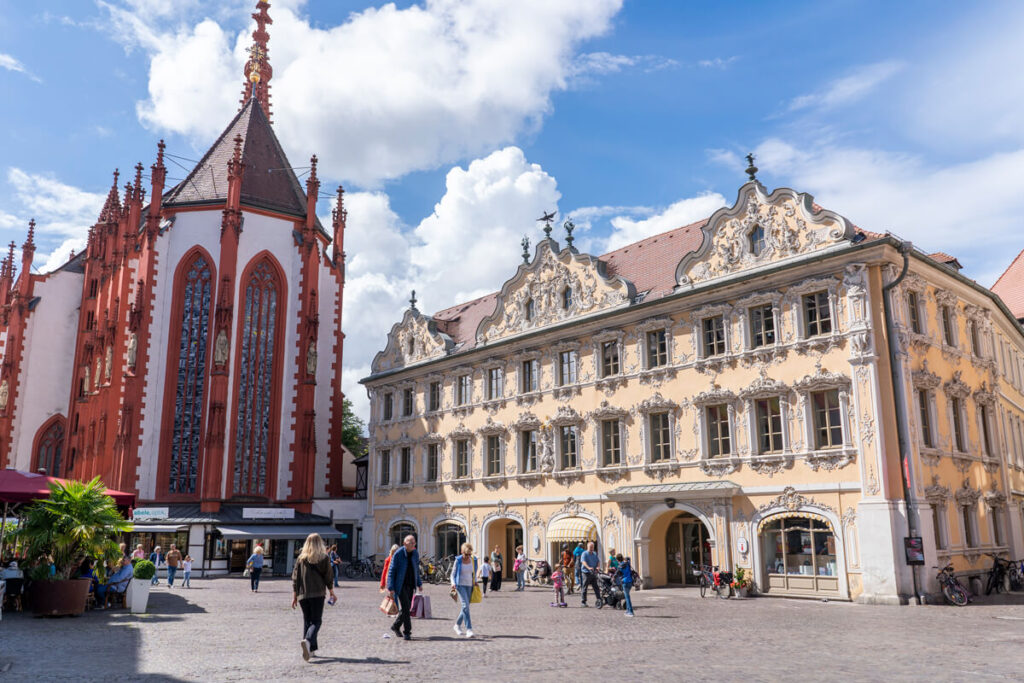
5. Würzburg Town Hall
Immediately in front of the Old Main Bridge is the city hall and the historic Vierröhrenbrunnen fountain. The town hall, consisting of several buildings, was built in 1898 and 1900, but was unfortunately destroyed in World War II. The town hall was reconstructed and rebuilt in the early 1950s. The oldest part of the town hall is the Grafeneckart with its 55-meter-high Romanesque tower. Today, it houses a documentation room about the bombing of the city on March 16, 1945.
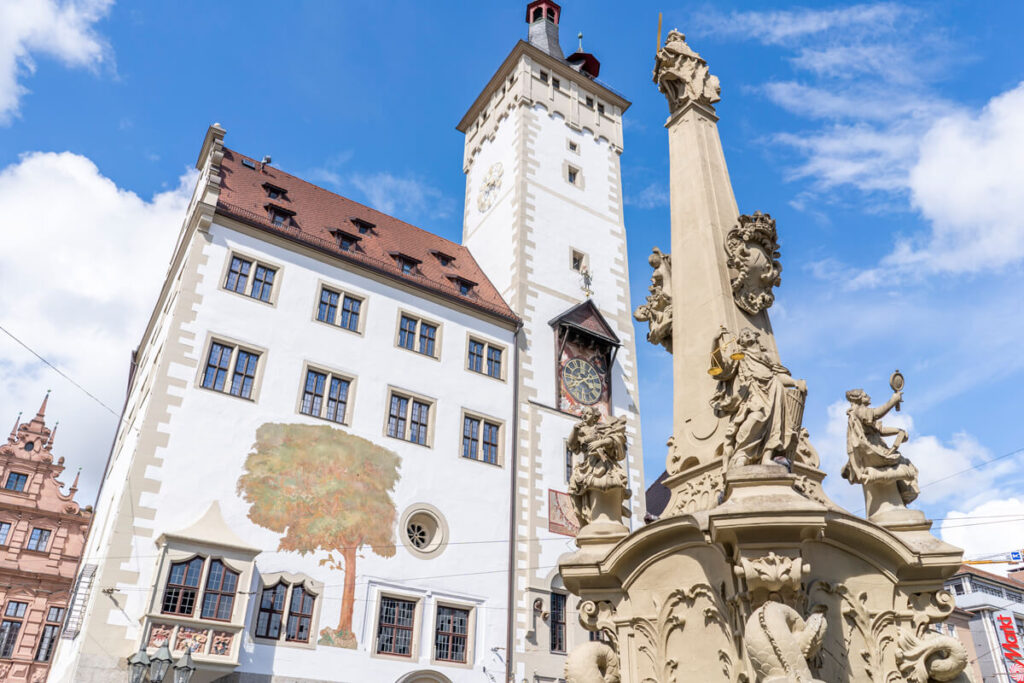
6. Old Main Bridge & Brückenschoppen
The Old Main Bridge is also one of Würzburg’s top sights and is also the oldest bridge over the Main in the city. Construction of this bridge began in the 15th century, and until 1886, it was Würzburg’s only river crossing. It connects the Old Town on the right bank of the Main with the opposite district and the Marienberg Fortress.
On the bridge, you’ll find 12 stone figures, which are an impressive testament to the historical and artistic significance of this bridge (similar to the Prague’s Charles Bridge). Today, the Old Main Bridge is mainly used by pedestrians and cyclists.
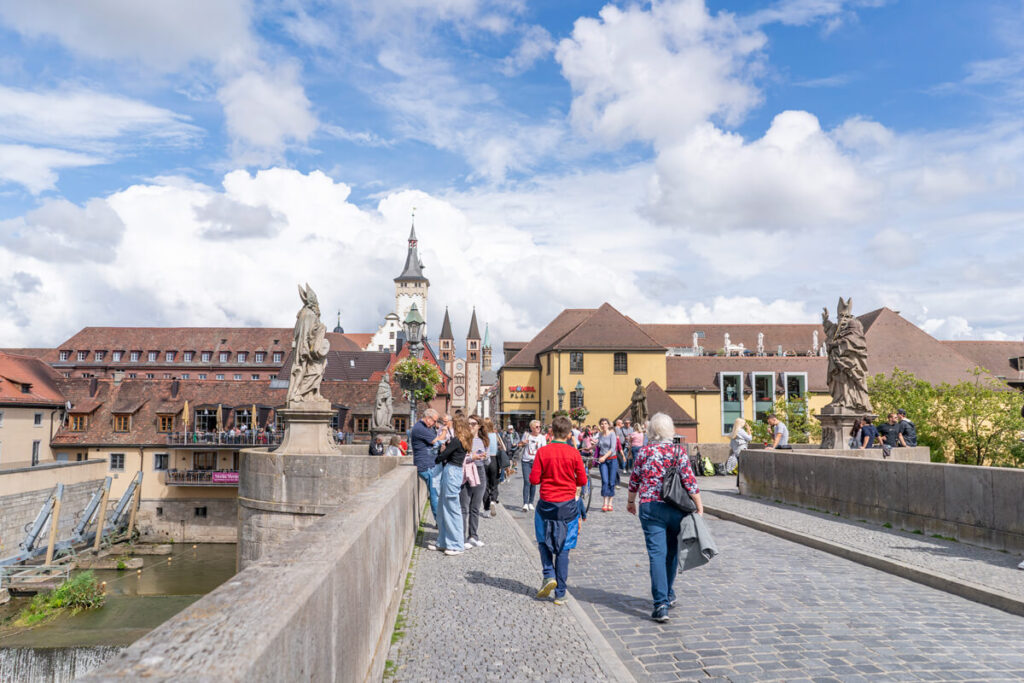
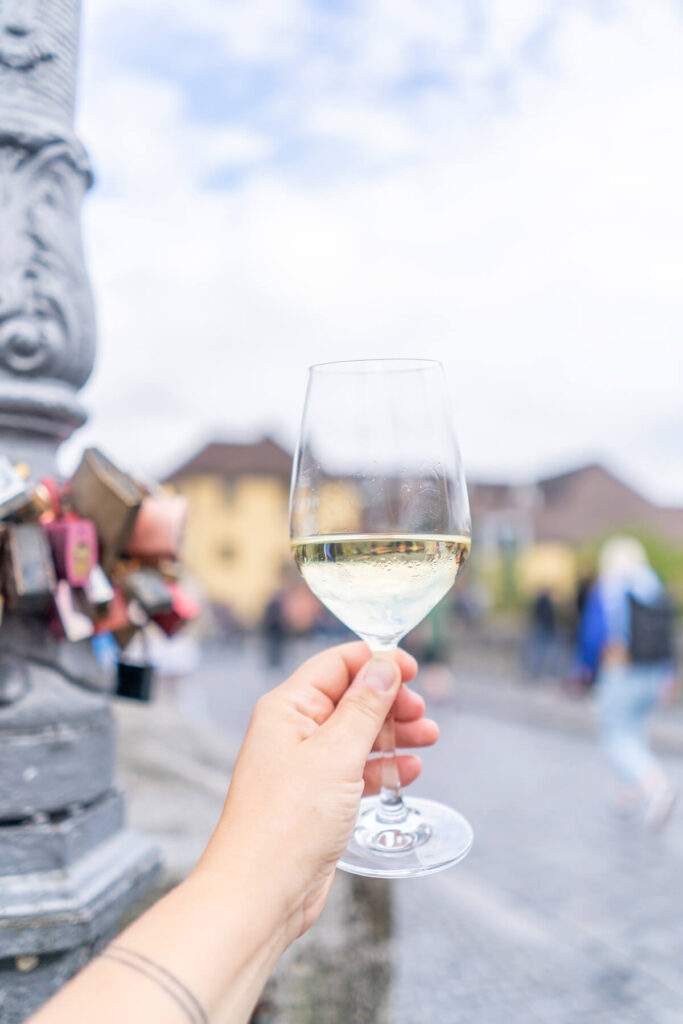
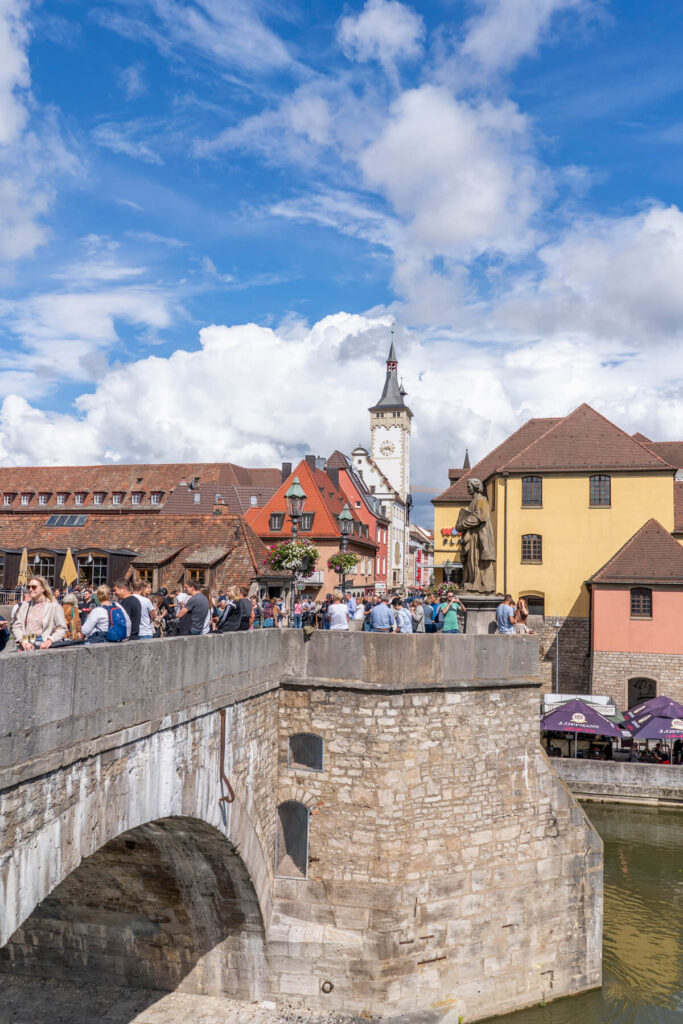
7. Alter Kranen
While taking a walk along the banks of the Main River, we discovered the “Alter Kranen”. The name “Alter Kranen” refers to a baroque crane that was once used to lift goods and merchandise from ships on the banks of the Main River and transport them into the city. A large treadwheel and pulleys were installed inside the building, operated by human hands. This allowed heavy loads to be lifted from the banks of the Main River and transported into the city. While the adjoining warehouse was destroyed in World War II, the “Alter Kranen” survived this dark period of our history virtually unscathed.
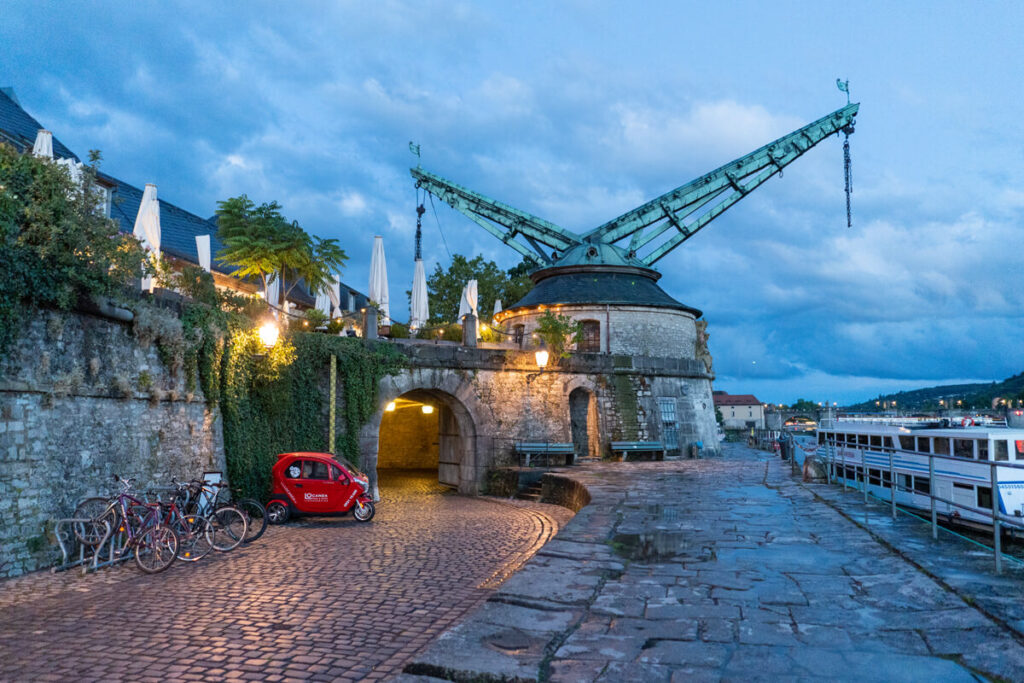
8. Museum im Kulturspeicher
Würzburg has not only sights to offer in the old town, but also just outside. Since 2002, the Museum im Kulturspeicher has found its home in the Kulturspeicher, a historic harbor warehouse that is a listed monument. The museum presents works of art from the 19th century to the present day on 3,500 m2 of exhibition space. In addition to the permanent collection, the museum in the Kulturspeicher also regularly organizes temporary exhibitions covering various themes and art forms.
- Address: Oskar-Laredo-Platz 1, 97080 Würzburg
- Opening hours: Tue. 1 p.m. – 6 p.m. | Wed. + Fri. – Sun. 11 a.m. – 6 p.m. | Thu. 11 a.m. – 7 p.m.
- Admission prices: €4.50 regular; €2.50 reduced
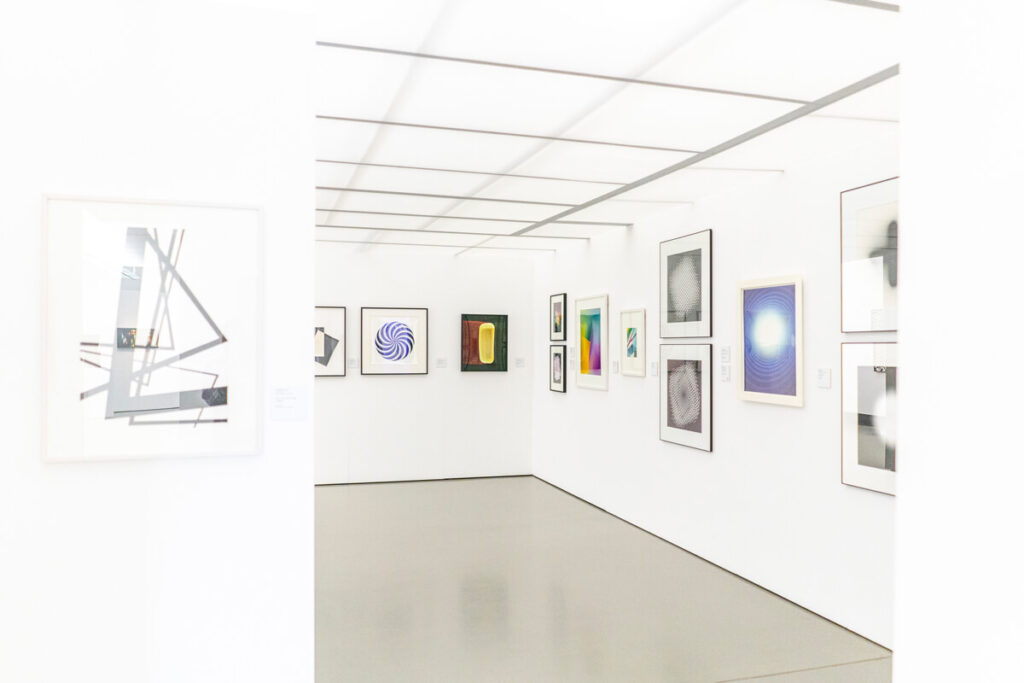
9th Würzburg Harbor Summer
Next year, the popular Harbor Summer Festival will take place again in the Old Harbor between the Kulturspeicher and the combined heat and power plant. Over 17 days, concerts will be offered for all tastes and ages. The musicians will perform on a floating stage amidst an incomparable backdrop. We were also there and were able to experience two talented musicians live and enjoy the late summer atmosphere. Click here for the event calendar.
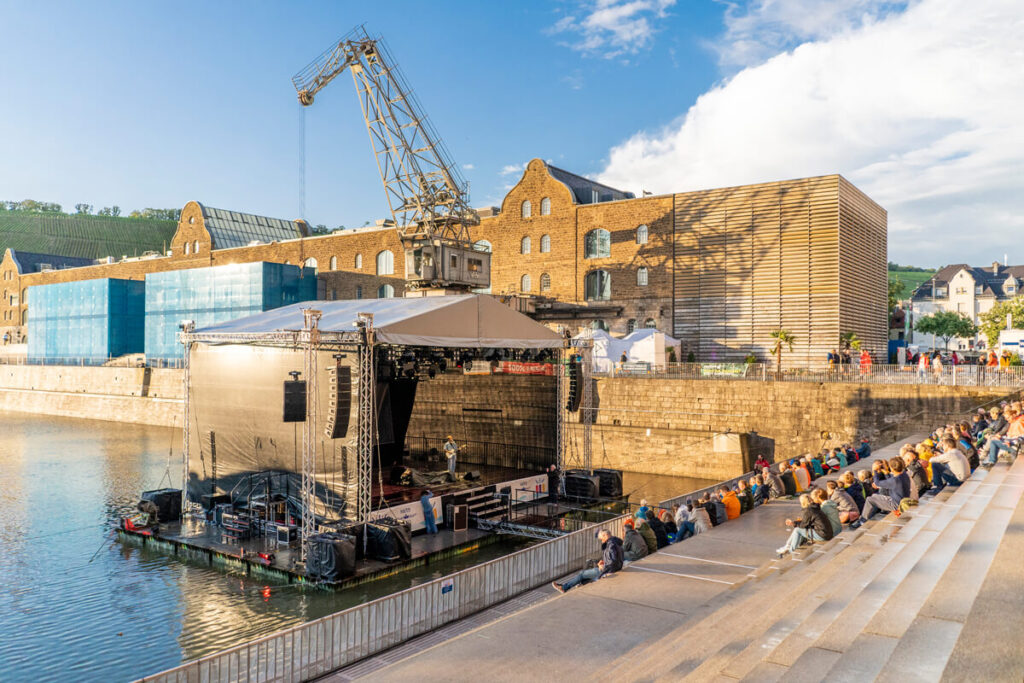
10. Zukunftshaus
There are countless cool shops and boutiques in Würzburg. But we’d like to introduce you to a very special establishment: the Zukunftshaus at Augustinerstraße 4. Here, everything revolves around sustainability in everyday life. The special thing about this store is that you can not only buy countless products here, but also rent/borrow and exchange them. You can also have your electronics repaired on site, so you don’t have to throw them away. The concept is really great, so be sure to stop by!
- Address: Augustinerstraße 4, 97070 Würzburg
- Opening hours: Monday – Saturday from 10 a.m. to 6 p.m.
- Website: www.zukunftshaus-wuerzburg.de
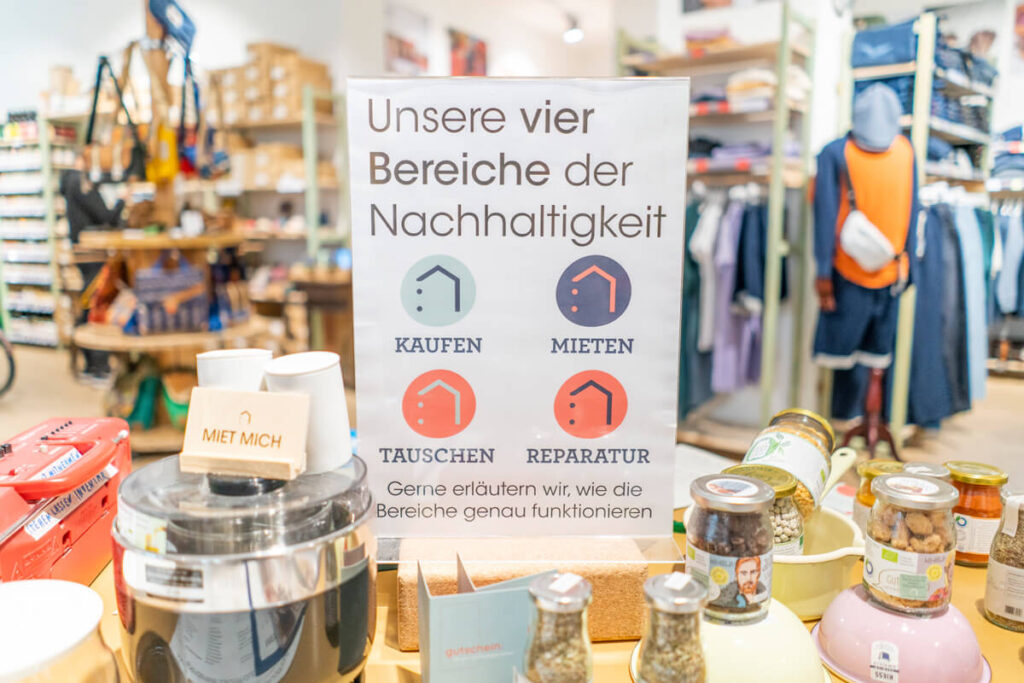
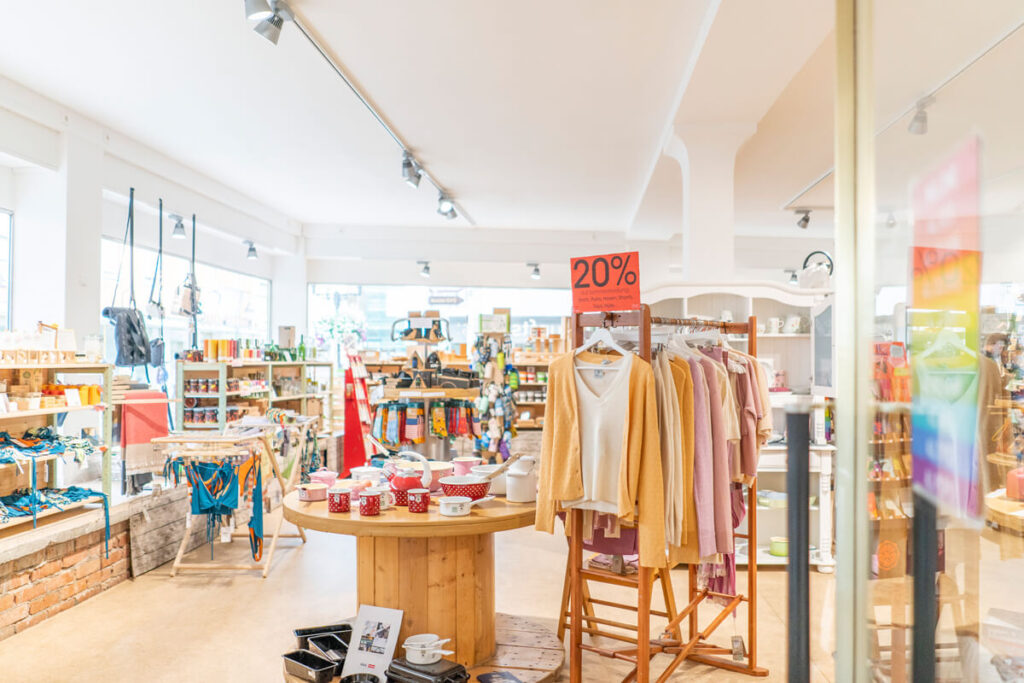

11. Marienberg Fortress
On the first day of our trip, we were unfortunately unlucky with the weather. It poured with rain, which meant we couldn’t see some of the spots. The Marienberg Fortress was unfortunately one of them. It sits high above the city on a hill on the banks of the Main River and is one of the city’s most famous landmarks. The Marienberg Fortress is surrounded by lush vineyards and offers a majestic view of the historic university town, which is characterized by domes, towers, and bridges.
We would have loved to visit the 1300 square meter Prince’s Garden with its elaborate terraces, which was created in the early 16th century. The view from there is said to be magnificent. The interior of the fortress houses the Museum of Franconia. Note: Due to renovation work, the inner castle with its courtyard, keep, St. Mary’s Church, fountain house, and access to the Prince’s Garden have been closed since summer 2023.
- Address: Marienberg, 97012 Würzburg
- Opening hours: April-October: 9 a.m.-6 p.m. | November-March: 10 a.m.-4:30 p.m.
- Special feature: Closed on Mondays
- Castle tours: 10 a.m., 11 a.m., 1 p.m., 2 p.m., 3 p.m., and 4 p.m. (in winter 11 a.m., 1 p.m., 2 p.m., and 3 p.m.)
- Tour prices: €4 regular; 3 € reduced
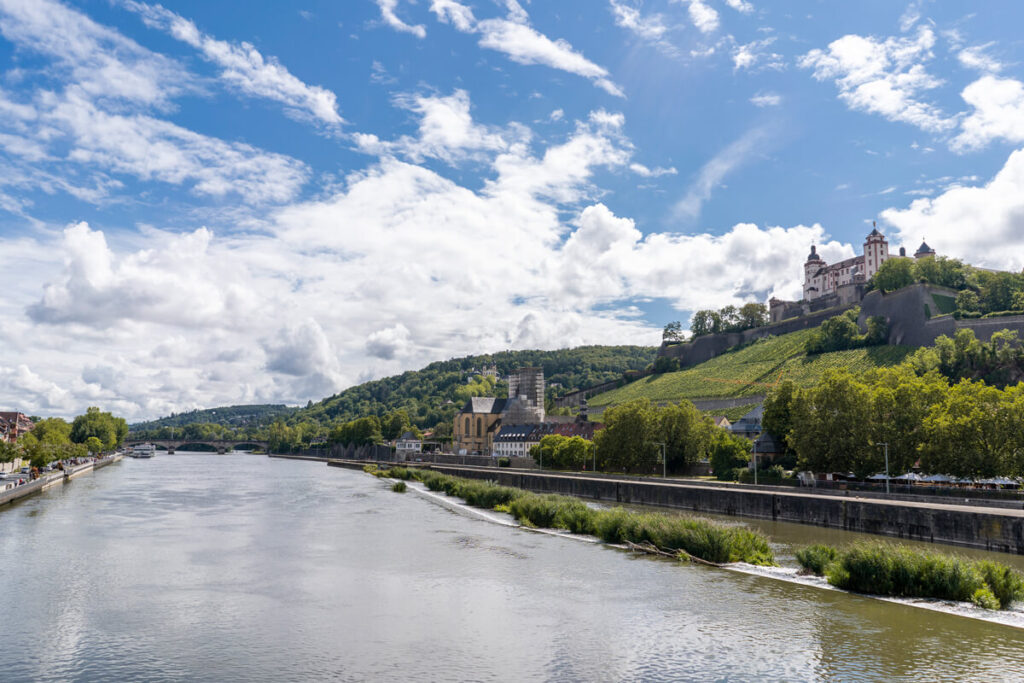
12. Other Highlights in Würzburg
Around the market square you will find further sights. Among them is the baroque and neoclassical Juliusspital with its own winery. With an area of around 180 hectares, the winery is actually the second largest winery in Germany. Cellar tours and wine tastings are offered on site, among other things. Don’t miss the Schustergasse. Colorful lanterns hang here in the summer months, and Christmas balls, tinsel, and other ornaments hang here in the winter.
During a city tour, we discovered the small but charming Lusam Garden, located on the north side of Neumünster Church. This small oasis of peace houses the grave of the famous minstrel Walther von der Vogelweide. Another Würzburg landmark is the so-called “Käppele” pilgrimage church, which is also located on the side of Marienberg Fortress. A visit to the university’s Botanical Garden is also worth it (admission is free).
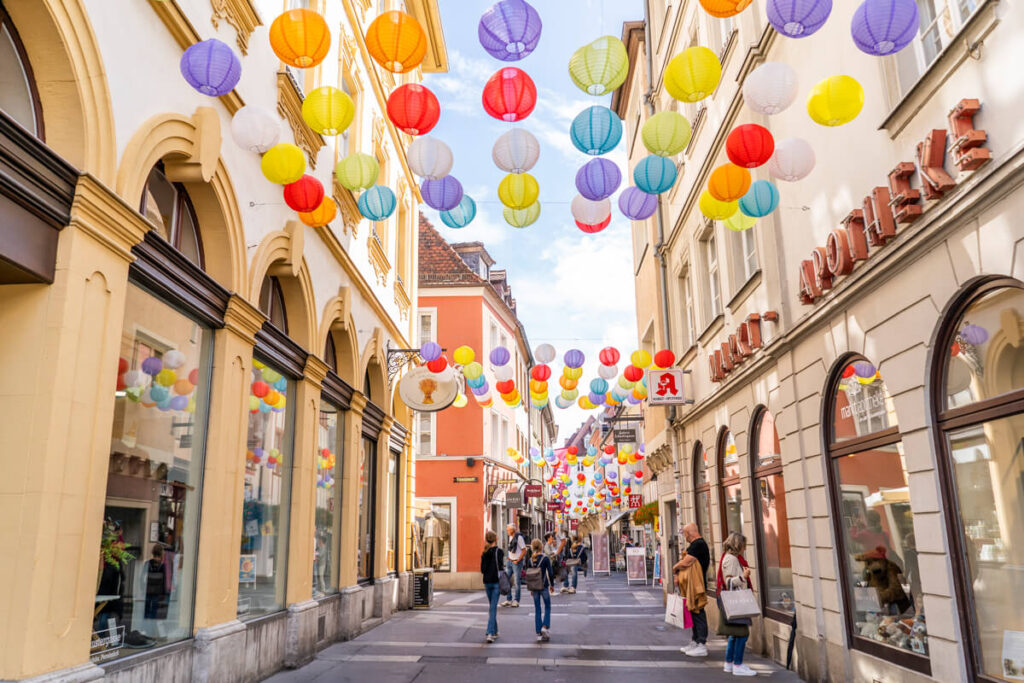
Restaurants & Cafés
Vrohstoff: Looking for vegan, gluten-free, and low-allergen cuisine? Then head to the “Vrohstoff” restaurant. They have a great, varied menu. We really enjoyed it!
Café Fred: At Café Fred, we had a delicious breakfast, cake, and coffee. We can recommend, among other things, the avocado bread with cream cheese, arugula, and black sesame seeds!
MainCake: Oh my goodness! We love cheesecake! At MainCake, you can get creative cheesecake variations that not only look good, but also taste incredibly delicious.
Café Wunschlos Glücklich: Whether waffles, breakfast, salads, small snacks, soups, or bowls—Café Wunschlos Glücklich has almost everything. The small courtyard is also really cozy.
Weinhaus Stachel: For over six centuries, Weinhaus Stachel has been an established, traditional business in the heart of Würzburg’s city center. The menu primarily features regional specialties.
Café Senza Limiti: The inclusive Café Senza Limiti, which works with people with and without disabilities, has been open in Würzburg since 2021. The term is Italian and means “limitless.”
CiCo Gelateria Artigianale: As always, ice cream is a must on any city trip. At the CiCo ice cream parlor in the city center, you can get incredibly delicious and creamy ice cream variations.
Kaffeemanufaktur – Würzburg’s coffee roastery: And a really good coffee is a must, too. At the Kaffeemanufaktur, you can get high-quality, fairly traded, and carefully cultivated coffee.
Brotzeitbar: Whether for a quick coffee, a snack, or a piece of cake – a visit to the Brotzeitbar is always worthwhile. Here, great importance is placed on high quality and regional products.
Nähcafé Edeltraud: This small, charming café not only offers incredibly delicious espresso, but also sewing classes, open mics, readings, and other small events.
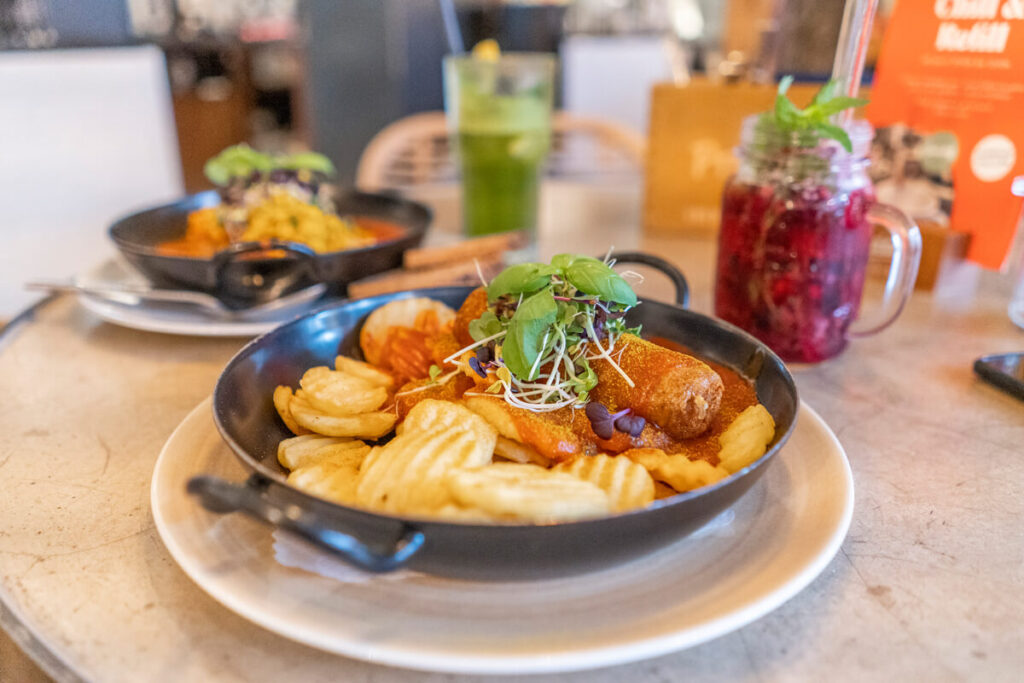
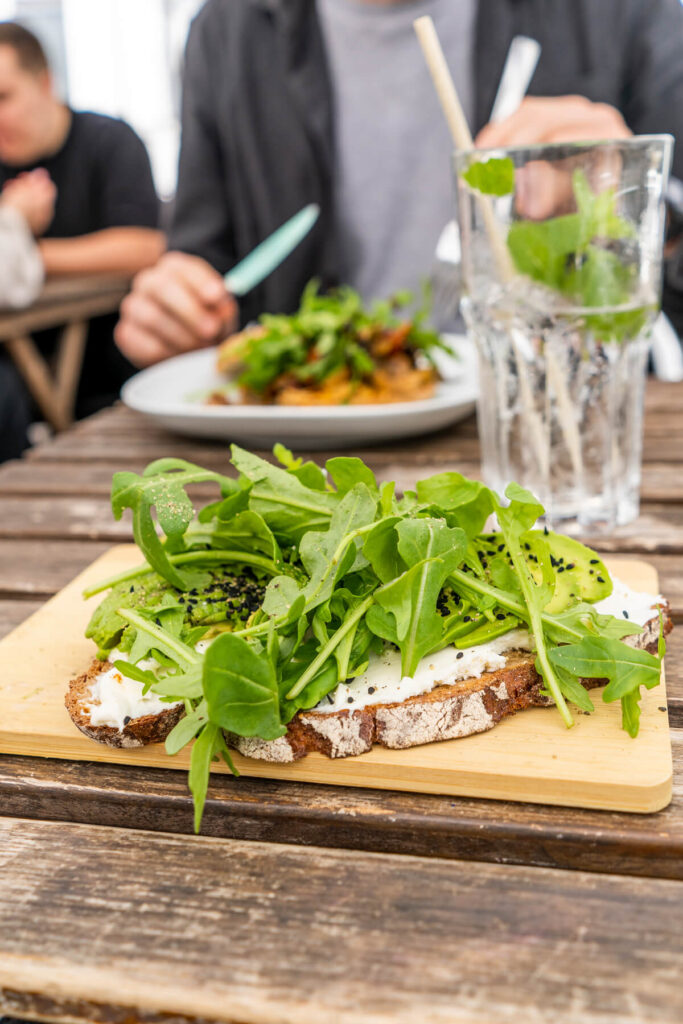
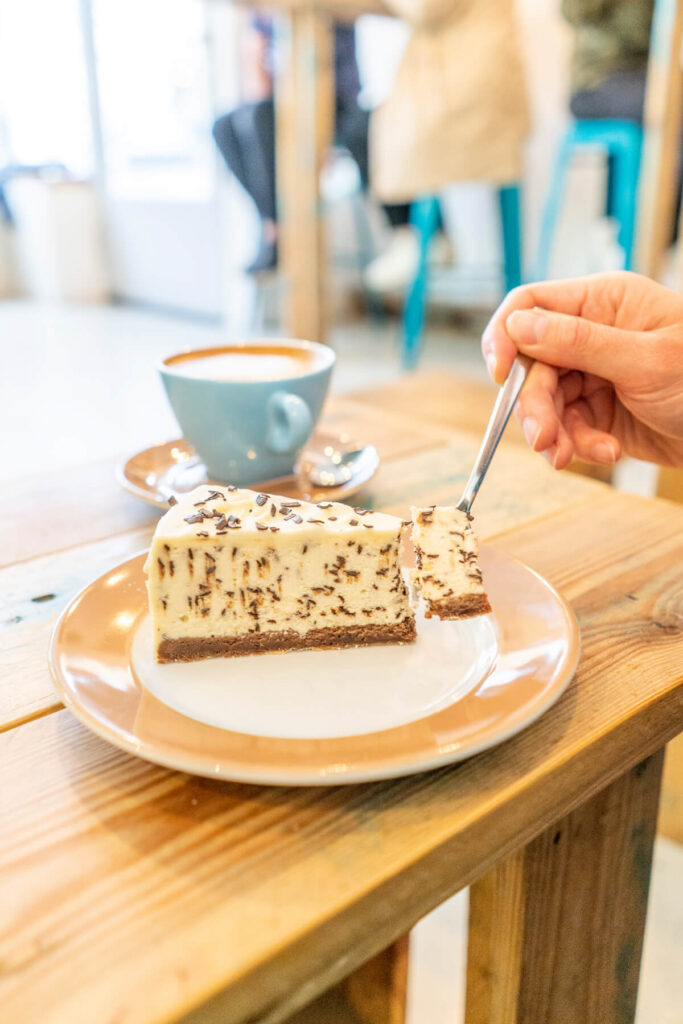
Events in Würzburg
Numerous festivals, concerts, and celebrations take place in Würzburg throughout the year. We’ve picked out a few cool events for you that are particularly special for Würzburg:
Mozart Festival Würzburg: The renowned Mozart Festival has been taking place in Würzburg in early summer since 1921. Every year, this festival attracts almost 35,000 visitors who are transported into the world of the famous composer at around 80 individual concerts. More about it here.
Africa Festival: The Africa Festival has been taking place annually in Würzburg since 1989. It is considered the largest and oldest festival for African music and culture in all of Europe. More than 7,630 musicians and artists from 56 different countries in Africa and the Caribbean have taken to the festival stages to date, delighting over 2,675,000 visitors. More information here.
Free & Outdoor Festival: The Free & Outdoor Festival in Würzburg has been a popular music festival since 1987, taking place on the Main River meadows. What’s special about it: admission is free! Every year in June, music lovers flock to this unique event to experience the over 50 talented bands performing on several stages. More information here.
Kiliani Folk Festival: Every summer, Lower Franconia’s largest folk festival takes place in Würzburg. In addition to the traditional costume parade and rides, there is also a large festival tent and numerous beer gardens. More information here.
Würzburg Bach Days: At various venues, the Würzburg Bach Days present a diverse program focusing on the work of the famous Baroque composer Johann Sebastian Bach. More information here.
Würzburg Christmas Market: Würzburg also boasts a Christmas market. Around 100 stalls offer a wide range of products in a historic setting in front of the Marienkapelle and the Falkenhaus. More information here.
Our Hotel in Würzburg
During our time in Würzburg, we stayed at the solid GHOTEL hotel & living Würzburg*. This hotel is about a 12-minute walk from the train station and 10 minutes from the old town. The rooms are quite simply designed and furnished. However, we had a great view of the city. Unfortunately, we only experienced the hotel during its renovation phase, so we cannot comment on the service, the breakfast room, or the terrace. Unfortunately, it was a large construction site.
Alternatives:
- Hotel Würzburger Hof*
- Mercure Hotel Würzburg am Mainufer*
- Moxy Würzburg*
- DAS v EVERT Hotel*
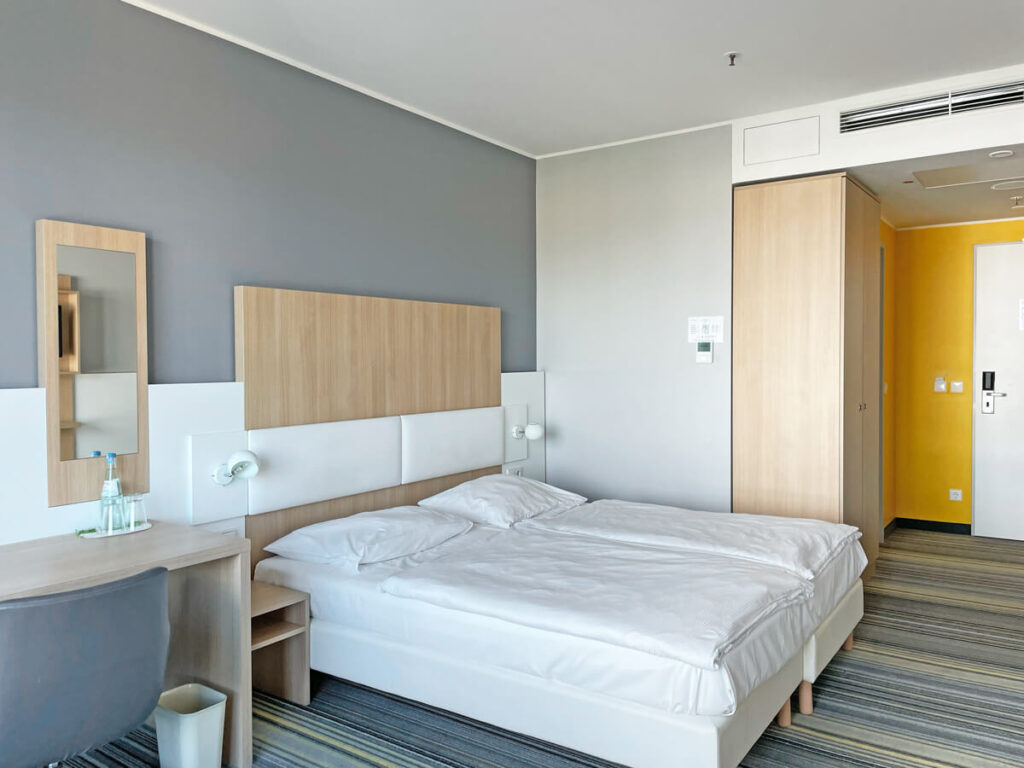
Travel tips for Würzburg
By car: If you are traveling by car, you can use the A3 and A7 motorways, which connect Würzburg with other major cities in Germany. Würzburg is easily accessible from Frankfurt, Nuremberg, Stuttgart and other cities. From Frankfurt and Nuremberg, it takes just 75 minutes to get to Würzburg, and from Stuttgart, it takes 90 minutes.
Distances to Würzburg:
- Hamburg: 508 km
- Berlin: 483 km
- Cologne: 301 km
- Munich: 277 km
- Stuttgart: 148 km
- Frankfurt: 120 km
- Nuremberg: 109 km
By train: Würzburg has a main train station, which is an important hub in the German rail network. You can travel directly to Würzburg by train from many German cities, including Frankfurt, Nuremberg, Munich, and Stuttgart. From Stuttgart, it’s only 2 hours by regional train and 1 hour by ICE from Nuremberg or Frankfurt.Book train tickets now*.